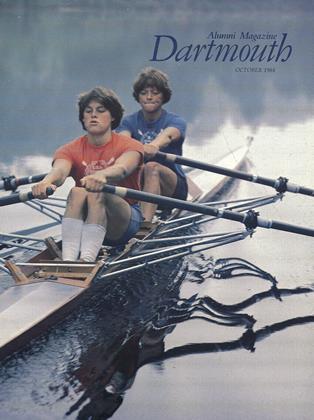When the residents of the Fayer weather Halls returned to campus in September, they found their old haunts under construction. Actually, the Fayers are "over" construction, since the threedorm complex behind Dartmouth Hall is getting a major facelift at the basement level.
The renovations will not alter the Fayer weathers' familiar facade. There will be new below-ground connectors linking the three dormitories and opening onto Observatory Road at the rear of the buildings. In what are now holes between the dorms will be a study room to the north and, on the south, a multipurpose room with kitchenette, designed to foster cultural and social events. The cellar space of Middle Fayerweather will be renovated to provide office space for faculty master Donald Pease of the English department, a computer room, and space for typewriters. All of this will enable students to study in the dorms without being in their rooms. In addition to the subterranean changes, each dorm will have carved out of its ground-level space a large area facing the foyer, designed to serve the same purpose as a residential living room.
This construction comes on the heels of recent renovations at the Choate Road dormitories and will be followed by changes at the River Cluster, Topliff, and New Hamp and by construction of a new dorm cluster on East Wheelock Street. It's all part of a $17.1-million commitment by the Trustees to residential renovations in order to implement the suggestions in a report on residential life by the Committee on Undergraduate Life (CUL). The report recommended that each dormitory cluster have spaces to "support the social, recreational, cultural, and educational life of the residence halls": multi-purpose rooms, faculty master spaces, study areas, snack preparation areas, and lounge spaces. In addition to making recommendations for the cluster areas, the CUL report supported the availability of a variety of dorm options clusters; "independents" such as Wheeler, Hitchcock, and North; and "affinity houses" such as the Co-op and Native American Houses.
With this variety of residential choices and the abundance of social, recreational, educational, and cultural opportunities on campus, one might wonder about the need for additional expense to upgrade the dorms. Dean of Residential Life Cristia Lesher explains: "The dormitories at Dartmouth have traditionally consisted of student rooms, hallways, baths, and stairs." The objective of the renovations is to create a more homelike environment "so that dorms feel more like a house, clusters become more of a neighborhood."
Lesher is quick to point out that the CUL recommendations are "not cookie cutters to impose on each cluster. They are imposed to make sense." The committee responsible for developing the renovation plan for the Fayerweathers was concerned with maintaining the individual character of each dorm within the cluster. Thus, each of the three dorms has a living room rather than there being a larger lounge space for the whole cluster.
In addition to getting structural renovations, dorm clusters are becoming more organized. There are faculty masters, elected cluster councils to provide the various types of programming outlined in the CUL report, and student "area coordinators" who live in the clusters and are paid by the Office of Residential Life to administer programs and troubleshoot.
The need and desire for dorm-based cultural and educational programs can be attested to by this past year's successes. There were 225 programs an average of one every night of the academic calendar ranging from talks on reading and study skills to a movie series on discrimination, the latter drawing an SRO crowd.
Despite the current emphasis on upgrading the dorms, Lesher expects the percentages of students living in dorms, in Greek houses, and off-campus to remain constant. She reiterates her hope that the variety of living situations will meet the differing needs of students and that each residence type and area will develop a distinctive atmosphere, thus fostering diversity. But fostering a sense of campus community is important as well: "Dartmouth is a centralized place," she explains. "Decentralized residences would be very alien to what has traditionally occurred at the College."
Dartmouth, in its first splendid vagueness, came into sight this morning as the White River bus rounded the last curve. . . . The simple green and white grandeur of the old Hall and its brother buildings was on our right: before us stood the wonderful new library, its tower rising above the elms; and on our left was the Administration Building whence we would push off on our College careers." -Entry in a diary of his freshman year by Dexter Martin '36
 View Full Issue
View Full Issue
More From This Issue
-
 Feature
FeatureThe Class of 1930 Room Public Service Wall
October 1984 By Charles E. Widmayer '30 -
 Cover Story
Cover StoryGeared for Success
October 1984 By Jim Kenyon -
 Feature
Feature"Little Joe" Wentworth, 1900: Scholar, Athlete, Gentleman
October 1984 By John F. Anderson '34 -
 Feature
Feature"The Computer Revolution" Revisited
October 1984 By George O'Connell -
 Article
ArticleA Post-game Peregrination
October 1984 By Dana Cook Grossman -
 Article
ArticleGetting Better with Age
October 1984 By Gayle Gilman '85
Dana Cook Grossman
-
 Article
ArticleVox
October 1980 By Dana Cook Grossman -
 Article
ArticleQuirkiness to Taste
December 1980 By Dana Cook Grossman -
 Books
BooksMore Than Work
April 1981 By Dana Cook Grossman -
 Feature
FeatureWhat keeps them going? A 'Mystic Glue' Perhaps
MAY 1982 By Dana Cook Grossman -
 Article
ArticleA Post-game Peregrination
OCTOBER 1984 By Dana Cook Grossman -
 Article
ArticleCollege to purchase hospital buildings
JANUARY/FEBRUARY 1986 By Dana Cook Grossman
Article
-
 Article
ArticleS. A. T. C. MEMBERS TRANSFERRED
December 1918 -
 Article
ArticleValedictory to Class of 1941
July 1941 -
 Article
ArticleDown the Middle
July/Aug 2009 -
 Article
ArticleCleveland
MARCH 1968 By EDWARD OBERNDORF '52 -
 Article
ArticleBASEBALL
May 1950 By Francis E. Merrill '26 -
 Article
ArticleAbout 25 Years Ago
April 1938 By Warde Wilkins '13.


